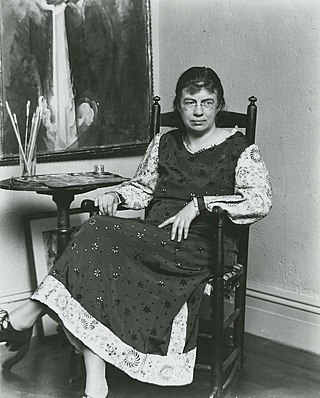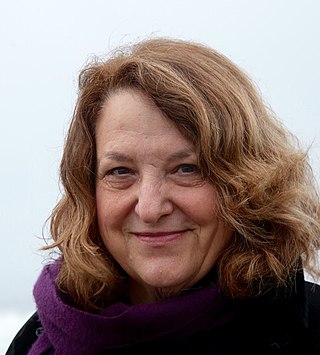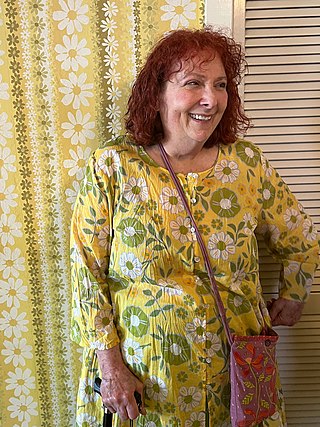Related Research Articles

Judy Chicago is an American feminist artist, art educator, and writer known for her large collaborative art installation pieces about birth and creation images, which examine the role of women in history and culture. During the 1970s, Chicago founded the first feminist art program in the United States at California State University, Fresno which acted as a catalyst for feminist art and art education during the 1970s. Her inclusion in hundreds of publications in various areas of the world showcases her influence in the worldwide art community. Additionally, many of her books have been published in other countries, making her work more accessible to international readers. Chicago's work incorporates a variety of artistic skills, such as needlework, counterbalanced with skills such as welding and pyrotechnics. Her most well-known work is The Dinner Party, which is permanently installed in the Elizabeth A. Sackler Center for Feminist Art at the Brooklyn Museum. The Dinner Party celebrates the accomplishments of women throughout history and is widely regarded as the first epic feminist artwork. Other notable art projects by Chicago include International Honor Quilt, Birth Project, Powerplay, and The Holocaust Project. She is represented by Jessica Silverman gallery.

Marguerite Zorach was an American Fauvist painter, textile artist, and graphic designer, and was an early exponent of modernism in America. She won the 1920 Logan Medal of the Arts.
Amelia Jones, originally from Durham, North Carolina, is an American art historian, art theorist, art critic, author, professor and curator. Her research specialisms include feminist art, body art, performance art, video art, identity politics, and New York Dada. Jones's earliest work established her as a feminist scholar and curator, including through a pioneering exhibition and publication concerning the art of Judy Chicago; later, she broadened her focus on other social activist topics including race, class and identity politics. Jones has contributed significantly to the study of art and performance as a teacher, researcher, and activist.
Faith Wilding is a Paraguayan American multidisciplinary artist - which includes but is not limited to: watercolor, performance art, writing, crocheting, knitting, weaving, and digital art. She is also an author, educator, and activist widely known for her contribution to the progressive development of feminist art. She also fights for ecofeminism, genetics, cyberfeminism, and reproductive rights. Wilding is Professor Emerita of performance art at the School of the Art Institute of Chicago.

Lynn Hershman Leeson is an American multimedia artist and filmmaker. Her work with technology and in media-based practices is credited with helping to legitimize digital art forms. Her interests include feminism, race, surveillance, and artificial intelligence and identity theft through algorithms and data tracking.

June Claire Wayne was an American painter, printmaker, tapestry innovator, educator, and activist. She founded Tamarind Lithography Workshop (1960–1970), a then California-based nonprofit print shop dedicated to lithography.

The feminist art movement in the United States began in the early 1970s and sought to promote the study, creation, understanding and promotion of women's art. First-generation feminist artists include Judy Chicago, Miriam Schapiro, Suzanne Lacy, Judith Bernstein, Sheila de Bretteville, Mary Beth Edelson, Carolee Schneeman, Rachel Rosenthal, and many other women. They were part of the Feminist art movement in the United States in the early 1970s to develop feminist writing and art. The movement spread quickly through museum protests in both New York and Los Angeles, via an early network called W.E.B. that disseminated news of feminist art activities from 1971 to 1973 in a nationally circulated newsletter, and at conferences such as the West Coast Women's Artists Conference held at California Institute of the Arts and the Conference of Women in the Visual Arts, at the Corcoran School of Art in Washington, D.C..
Vivienne Joyce Binns is an Australian artist known for her contribution to the Women's Art Movement in Australia, her engagement with feminism in her artwork, and her active advocacy within community arts. She works predominantly in painting.

Sonya Rapoport was an American conceptual, feminist, and New media artist. She began her career as a painter, and later became best known for computer-mediated interactive installations and participatory web-based artworks.
Mary Kelly is an American conceptual artist, feminist, educator, and writer.
Martha Wilson is an American feminist performance artist and the founding director of Franklin Furnace Archive art organization. Over the past four decades she has developed and "created innovative photographic and video works that explore her female subjectivity through role-playing, costume transformation, and 'invasions' of other peoples personas". She is a recipient of two National Endowment for the Arts fellowships, a New York Foundation for the Arts fellowship, and an Obie Award and a Bessie Award for commitment to artists’ freedom of expression. She is represented by P.P.O.W. Gallery in New York City.

Joyce Kozloff is an American artist known for her paintings, murals, and public art installations. She was one of the original members of the Pattern and Decoration movement and an early artist in the 1970s feminist art movement, including as a founding member of the Heresies collective.

Gilah Yelin Hirsch is a multidisciplinary artist who works as a painter, writer, curator, and filmmaker. Her work explores the connections between science, art, and spirituality. She has been a leader in the International Society for the Study of Subtle Energies and Energy Medicine (ISSSEEM). Hirsch was a founding member of one of the earliest women art organizations, the Los Angeles Council of Women in the Arts (LACWA) and was active in the feminist art movement in Southern California. She was a professor of art at California State University, Dominguez Hills in Los Angeles since 1973 and became Professor Emerita in 2020. Presently, Hirsch continues painting, writing, theorizing, and filmmaking, and is often invited to present her work in conferences and webinars world-wide.
The Women's Caucus for Art (WCA), founded in 1972, is a non-profit organization based in New York City, which supports women artists, art historians, students, educators, and museum professionals. The WCA holds exhibitions and conferences to promote women artists and their works and recognizes the talents of artists through their annual Lifetime Achievement Award. Since 1975 it has been a United Nations-affiliated non-governmental organization (NGO), which has broadened its influence beyond the United States. Within the WCA are several special interest causes including the Women of Color caucus, Eco-Art Caucus, Jewish Women Artist Network, International Caucus and the Young Women's Caucus. The founding of the WCA is seen as a "great stride" in the feminist art movement.
Women's Art Resources of Minnesota (WARM) is a women's art organization based in the U.S. state of Minnesota. It was founded in 1976 as Women's Art Registry of Minnesota, a feminist artist collective. The organization ran the influential WARM Gallery in downtown Minneapolis from 1976 to 1991.
The Feminist Art Program (FAP) was a college-level art program for women developed in 1970 by artist Judy Chicago and continued by artists Rita Yokoi, Miriam Schapiro, and others. The FAP began at Fresno State College, as a way to address gender inequities in art education, and the art world in general. In 1971, Judy Chicago and Miriam Schapiro brought the FAP to the newly formed California Institute of the Arts, leaving Rita Yokoi to run the Fresno FAP until her retirement in 1992. The FAP at California Institute of the Arts was active until 1976. The students in the Feminist Art Program read women writers, studied women artists, and made art about being a woman based on group consciousness-raising sessions. Often, the program was separate from the rest of the art school to allow the women to develop in a greenhouse-like environment and away from discerning critiques. While the separatist ideology has been critiqued as reinforcing gender, the FAP has made a lasting impression on feminist art which can be seen in retrospectives, group exhibitions, and creative re-workings of the original projects.

Nancy Youdelman is a mixed media sculptor who lives and works in Clovis, California. She also taught art at California State University, Fresno from 1999 until her retirement in 2013. "Since the early 1970s Youdelman has been transforming clothing into sculpture, combining women's and girl's dresses, hats, gloves, shoes, and undergarments with a variety of organic materials and common household objects.

The Fresno Art Museum is an art museum in Fresno, California. The museum's collection includes contemporary art, modern art, Mexican and Mexican-American art, and Pre-Columbian sculpture.

Jean Ray Laury was an American artist and designer. She was one of the first fine artists to move to quilting as a medium of choice in the late 1950s. Her quilts followed neither traditional method nor pattern; they were bold, modern, colorful collages, often laced with humor and satire. Penning over twenty books and teaching over 2,000 workshops, Laury helped women see the creative possibilities in everyday objects and awake their sense of inspiration. Laury has been called a "foremother of a quilt revival", and "one of the pioneers" of non-traditional quilts.
Orly Cogan is an Israeli-American fiber artist who works with and combines multiple mediums. She is best known for crafting hand stitched embroidered figures on top of previously embroidered vintage fabrics.
References
- 1 2 3 4 5 6 7 8 Barbara J. Love (2006). Feminists who changed America, 1963-1975 . University of Illinois Press. p. 6. ISBN 978-0-252-03189-2 . Retrieved 7 January 2012.
- 1 2 "A Studio of Their Own: The Legacy of the Fresno Feminist Art Experiment". Legacy/History. California State University, Fresno. Archived from the original on 29 October 2017. Retrieved 8 January 2011.
- ↑ "History of Gallery 25". About us. Gallery 25. Archived from the original on 23 November 2010. Retrieved 8 January 2011.
- ↑ Victor Ramayrat (2010). "Joyce Aiken Retirement Party". Vimeo . Retrieved 9 January 2011.
- ↑ Zenovich, Jennifer; Moreman, Shane (2015). "Third wave feminist analysis of a second wave feminist's art: A feminist oral history of an artist's last performance". Departures in Critical Qualitative Research. 4 (1): 57–80. doi:10.1525/dcqr.2015.4.1.57 . Retrieved February 27, 2024.
- ↑ "Public Art on the Fulton Mall". Fulton Mall Public Art Tour. Downtown Fresno. 2012. Archived from the original on 16 January 2011. Retrieved 7 January 2011.
- ↑ "39NOW". Sophia Louisa Projects. 2010. Archived from the original on 26 January 2011. Retrieved 8 January 2011.
- ↑ "Seeing Through It and Seeing It Through". Mixed Media Artworks. Jan Camp. 2012. Archived from the original on May 6, 2008. Retrieved 19 April 2012.